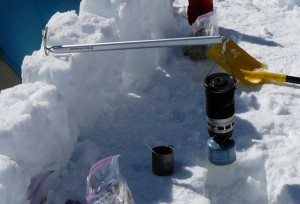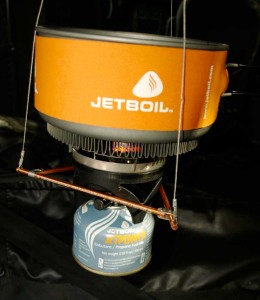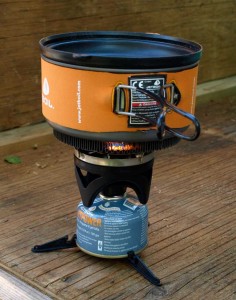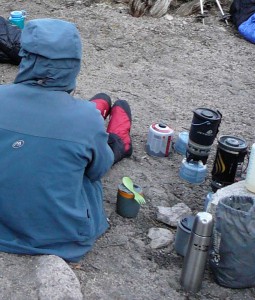Thus it took me a few years to transition to the new paradigm that Jet Boil represented to the world of backcountry stoves. Actually, it only took one meal, but that resistance to embrace change prevented me from even trying out a Jet Boil stove for at least two seasons and umpteen excuses. Just to try the stove out meant rethinking and completely revising my established cooking patterns. Woe to me for being so stubbornly silly.
It was on a backcountry ski tour, the Sierra High Route, that I learned to love the Jet Boil system. The light started to dawn simply in loading it in to the pack. All the pieces – the burner, igniter, and fuel fit inside the pot. Jet Boil is more than a stove, it’s a complete system optimized primarily for heating water, secondarily for cooking food directly.
The crux of the appeal is attention to detail that is applied to the entire heating system. Most backcountry stoves focus on making their stove the hottest, most efficient source of heat they can, but only with regard to the burner itself, and to some extent, the mechanical support system. Indeed this is an important first step but whether you’re cooking on a tailgate or in a tent in a snowstorm you can boil water faster if you take advantage of all the heat your stove is creating, which is why Jet Boil works so well.
One of the simple things Jet Boil does is provide a neoprene cozy around the circumference of all their pots, whether the personal or group sized pots, to insulate metal pot from the cold surroundings and also to make it easier to grasp with your hands when it is time to pour water into a waiting cup. The groups sized pots come with handles that fold to the side, and the smaller 1.0 and 1.5 liter pots have a strap of webbing to slip your hand into for pouring.
Better still, all the pots come with FluxRing® technology bonded to the base of the pot, which transfers more of the heat from the stove to the pot like an integrated heat exchanger.
The stove itself isn’t the hottest burner on the market, but when combined with efficient heat transfer and insulation, the Jet Boil regularly shames hotter burning stoves. Another part of the Jet Boil formula is the use of LP gas canisters that don’t require priming to start burning. Just screw them on to the burner, open the valve and press the button to ignite the gas with a piezo electric spark. No more problems with wasting or spilling gas in the priming stage, or waiting for the stove to stabilize. In addition the burner assembly is built to block wind. An external wind screen might still be needed on windy days, but if you’re cooking in a tent, the built-in windscreen does a good job in light winds to keep the heat directed into the pot, rather than be blown away.There is one side effect of using butane canisters that can affect heat output. As the stove burns down and the pressure inside is reduced the temperature of the fuel will drop, which further reduces vapor pressure and lowers heat output. If you’re snow camping you will want to disengage and keep the canister warm overnight, or build a cozy for the canister as well to insulate it from outside cold.
While on the Sierra High route we only used the smaller personal sized systems to save weight. In spite of the fact that each stove was responsible for heating water for four people dinner only took an hour which included having to first melt the snow to water before boiling it. That hour included two entrees for each man, usually a large cup of soup plus a full dehydrated meal, and another hot drink. The only complaint we had with the Jet Boil was the plastic lid that didn’t seal well, or come off easily. To be fair though, we were using a jury-rigged hanging system that pinched the lid and didn’t always hang very straight. I suspect if we had spent a few extra bucks and used Jet Boils hanging stove system we would have been happier.
About the only negative thing I can think of with the Jet Boil system is the use of canisters that can’t be refilled like the pressurized bottles used for white gas stoves. Although the canisters can’t be reused, Jet Boil at least offers a tool – the CrunchIt – that bleeds the last bit of gas out of an empty canister and then lets you puncture it like a can opener so it ceases to be a potential hazard in a land fill and could be recycled. It may not be a complete solution, but it’s a worthy step in the right direction.For car camping I still bring my Coleman two-burner along, but nowadays I also bring the Jet Boil too. When you want hot water fast, whether in the backcountry or operating from a tail gate, you can’t beat the simplicity, reliability or efficiency of Jet Boil.
Jet Boil
Flash Cooking System (1.0 liter)
MSRP: $100
Weight: 14 oz. (397 g)
Group Cooking System (1.5 liter)
MSRP: $115
Weight: 20 oz. (567 g)
© 2012





2 comments
Interestink.
Can you give an estimate of fuel usage per l. of water boiled?
According to JetBoil “a single 100-gram canister boils 10 liters of water”. That’s probably at sea level, so maybe 8 liters to account for variations in elevation, or general inefficiency on the part of the cook. I haven’t kept track but my experience agrees with JetBoil, although I’ve done my share of wasting fuel too.